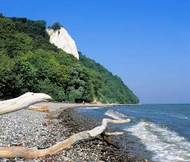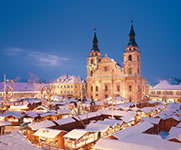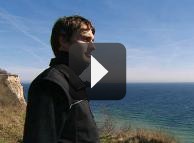Rügen is Germany's largest island (976 square kilometres). More precisely, it is an archipelago of around 30 small islands and peninsulas in the Baltic Sea off the coast of Mecklenburg-Western Pomerania. Take a stroll round the newly resplendent, former imperial spa resorts and you will definitely sense the noblesse of the Belle Epoque. Rügen is a remarkably diverse island of genteel seaside resorts, quiet little fishing villages, mile-long beaches, dead straight tree-lined avenues, wild sea buckthorn hedges, ancient megalithic graves, 100-year-old lighthouses, eerie beech woods, sparkling lakes and the Jasmund National Park, Germany's smallest national park.
The great Romantic painter Caspar David Friedrich, who was born in Greifswald, brought fame to the majestic cliffs of snow-white chalk which rise so dramatically out of the blue-green sea. The most famous of the cliffs is the Königsstuhl (118 metres) on the Jasmund peninsula. Visitors to Rügen can enjoy water sports, walk or cycle along the paths to the flint fields near Mukran, visit the fine Granitz hunting lodge and look around Putbus, a former princely seat. The "Racing Roland" steam train puffs its way around the island from Lauterbach to Göhren via Putbus and Binz. It is a wonderfully nostalgic way to get around Rügen's main sights and seaside resorts.

Hiddensee is a small, car-free island (19 square kilometres) just off Rügen. It is part of the West-Pomeranian Boddenlandschaft National Park. Hiddensee is shaped like a sea horse nestling against the larger island. It is a creation of the Ice Age and the ocean currents. The lighthouse on the Dornbusch cliff offers glorious views of the picturesque village of Kloster, the harbour at Vitte and the flowering heathland to the south.
Hiddensee is an island of snowy-white sandy beaches - some almost like the Caribbean - steep, rugged cliffs, beech groves flooded with sunlight, rustling pine forests and expanses of salt marsh. The sea is all around - nothing more than a gentle ripple at times, but at others tossing up wild, frothy crests of spray. The southern tip of the Gellen sandbank is a paradise for birds and large parts of the island are designated nature conservation areas. Bicycle bells and the sound of horses' hooves set the tone on Hiddensee.
 Skip to content
Skip to navigation
Skip to subnavigation
Skip to search
Skip to content
Skip to navigation
Skip to subnavigation
Skip to search







